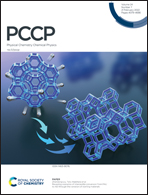Effect of cobalt phosphide (CoP) vacancies on its hydrogen evolution activity via water splitting: a theoretical study†
Abstract
Defect engineering plays an important role in improving the performance of catalysts. To clarify the roles of Co and P vacancies in CoP for water splitting, a theoretical study based on density functional theory was carried out in this paper. The geometric and electronic structures, activity and stability of the CoP (101)B surface, CoP (101)B with the Co vacancy (Covac) and the P vacancy (Pvac) are investigated. The results indicate that the CoP (101)B surface with Pvac and Covac can enhance the electron transfer to the surface. The Pvac will upward shift the Co d-band center near the vacancy site, which promotes the adsorption of H on the Co atom. As a result, the bridge Co–Co sites near the vacancy become the active sites for the hydrogen evolution reaction (HER) (ΔGH* = 0.01 eV). The loss of the Co atom also results in an upward shift of its d-band center, which will enhance the H adsorption on the adjacent Co sites. The unevenly distributed electrons due to the presence of vacancies on the surface cause spontaneous dissociation of H2O molecules. Furthermore, the thermodynamic analysis and surface energy find that the CoP (101)B and (101)B facets with Covac and Pvac present good stability. The current work has shed light onto the mechanism of water splitting on the surface of phosphide with vacancies. Our study suggests that engineering vacancies on CoP is a feasible route to improve its catalytic activity.



 Please wait while we load your content...
Please wait while we load your content...